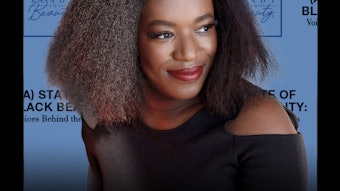- Though, historically, perms and relaxed hair were mainstays in the ethnic hair care market, the current market sees a variety of hair textures, styles, lengths and types, requiring an array of products and deeper market understanding.
- Natural ingredients continue to be a popular trend in ethnic hair care, as the need for healthy hair remains strong and consumers tend to be more trusting of natural ingredients that are also efficacious.
- To have a significant impact in the ethnic hair care market, brand owners need to consider the whole package—from ingredients to demographics to ongoing consumer interaction—in order to create brand preferences and loyalties.
With the world growing smaller every day, brand owners are constantly searching for new avenues for product innovations and line extensions, and one of the largest rising beauty segments is ethnic hair care. Though already a recognized niche market, the audience for ethnic hair care products continues to grow as brands extend their reach further around the globe with targeted offerings.
“There is a burgeoning market for ethnic beauty care, with hair care accounting for the lion’s share of ethnic beauty spending,” says Sabinsa Corporation’s marketing director Shaheen Majeed. With the market’s uniqueness, however, also come special considerations. “Historically, within the ethnic hair care market, perms and relaxants are important segments. Shampoos, conditioners and treatments are also gaining importance as these products are formulated to reduce breakage after chemical treatments and make hair more manageable,” Majeed notes.
The growing importance of this market has also highlighted the spots where more information and education is needed. “Sometimes, it’s about changing consumers’ basic hair care knowledge,” explains Shawn Tollerson, vice president of multicultural marketing for Colomer USA, the makers of Creme of Nature. “Some people grew up with unhealthy hair habits, so it’s about educating them on changing their behavior. We try to demystify what consumers believe versus what is true. We want to try to get them out of potentially bad hair habits and show them the healthy way it can and should be done.”
Common Issues
Though dynamic and constantly evolving, there are some basic needs the ethnic hair care market calls for, explains Majeed. “With its unique structure and texture, ethnic hair demands a specific care regimen,” he says. “While some African-American women rely on relaxing treatments for their hair, many take an approach to embrace their natural hair texture, but the ultimate and universal goal is to attain hair that is healthy, beautiful and natural. Ethnic hair can tend be dry and highly textured, so hair breakage can be a common problem.”
Additionally, the processing treatments many consumers in the ethnic hair care market use require targeted products to treat problems. “As many ethnic men and women use chemical processes to alter the style of their hair, actives that work to repair the damage caused by these processes are important,” says Charles Moses, applications and technical specialist, Croda Inc. Among the trends these active ingredients can address, according to Moses, are an increasing need for moisturization and frizz control. And yet another avenue the ethnic hair care market focuses on is scalp health.
Stephen Durham, founder and CEO of Urban Therapy, explains, “A healthy scalp is the base for great hair. A healthy scalp leads to better moisturization, which is very important if hair is colored as it will hold color better, and it can also help hair thinning at the scalp, to create a thicker, more lush feel.” Initially, it’s about creating healthy hair that is more pliable and easy to style for the diverse demands often put to it.
Of course, one of the longest-held treatments for ethnic hair has been relaxing it, but more and more, natural textures are also becoming popular among these consumers. “Texturizers are gaining momentum in the rapidly evolving ethnic hair care market, with style revival products being the mainstay,” Majeed notes. “Hair care products that are designed to repair and revitalize hair during each step of the styling process are in vogue and are gaining prominence, with the thrust being on natural products. There is an increased demand for proteins that moisturize and strengthen hair, and designing gels, protectant sprays, curl releasers, detanglers along with vitamin-enriched conditioners that add a natural healthy sheen to the hair are also popular.”
Because much of this market turns to various hair styles for self-expression, Tollerson notes the styles—and consequent issues—this market can see. “These women are doing a lot more experimenting with hair styles, really expressing themselves through their hair,” she says. “From curly waves to sharp lines to cute, short cuts, women emulate the styles they see in magazines and on celebrities and style icons, and even on their friends, and so we need to provide them with the products to do this with while maintaining healthy hair. This hair typically has a more curly structure, and that can result in the hair tending to be drier. It also has a tendency to be more fragile, so there’s a focus on products that can make hair healthy, pliable and shiny, and leave the consumer looking good.”
Other considerations for the development of products for the ethnic hair care market include hair texture, hair length and hair types, says Moses. “These factors will effect the efficacy of a product in regard to those parameters,” he explains.
Trending Up
Of course, all beauty categories grow stagnant without innovation, and the ethnic hair care market is no exception. Recently, it’s been seeing growth in the interest of natural products, as well as evolving into a more mature segment.
“In the past few years, this market has become really aware of super foods and better eating, focusing on health and exercise and an overall healthier lifestyle to be able to look and feel good,” explains Tollerson. “To translate that into hair care, there’s a focus on ingredients you see in foods and on grocery store shelves, natural ingredients to help achieve the healthiest hair possible.” “In terms of trends, many of our new products are focused on naturals, and more particularly, super fruits,” agrees Durham. “People have been hearing about the benefits of eating super fruits for some time now, and we’re seeing that what’s good for the body is good for the hair. Incorporating super fruits into our formulations is helping us deliver these naturally abundant benefits to hair.” Of the company’s Twisted Sista line, which recently launched in the U.S., Durham notes, “We’ve reformulated our product line with a few key ingredients, such as antioxidant-rich green tea, lychee extract, argan oil and vitamin E. We’ve also made sure they are sulfate- and paraben-free.”
Once again, it goes back to a base of healthy hair, and many consumers find it easier to trust a product that uses natural ingredients. “The most beautiful hair is the healthiest hair, and the health of hair is a reflection of one’s general health,” explains Majeed. “Natural ingredients protect, nourish and strengthen hair for maximum beauty, health and shine, and they effectively help in conditioning, cleansing and styling of hair.” Because of past hair damage issues and the consumer tendency to easily switch brands, developing efficacious products that ethnic hair care customers can trust will help develop and instill brand loyalty.
Market Evolution
As more companies enter the ethnic hair care market, brands will begin to need to sharpen their focus in order to differentiate themselves, and that sharp focus should consistently rely on meeting customer needs. Majeed says, “Adopting a customer-focused business ethos is a proven method to a profitable, and sustainable, future. Sabinsa is continually researching the evolving needs and preferences of the ethnic communities in the global population in order to make ingredients available to manufacturers that align their brands with that market’s requirements.”
But how do brand owners know where to look to next for market demands and changes? Tollerson notes that she often looks at international trends. “With the Internet, we can see trends and styles move so fast, so we watch the global marketplace—including Europe, South Africa, Brazil—to see what’s happening.”
For Croda’s ingredient and product development, Moses explains, “After reviewing market trends and determining the trends we expect to see for an area in the future, we can synthesize a product based on our knowledge of the chemistries involved, and then we will conduct instrumental testing on the product. We also develop formulations, conduct focus groups and perform salon validation to ensure our products are relevant for consumers. Our focus is on creating products that deliver a consumer perceivable benefit—so from synthesis of new ingredients to our salon work, the needs of the end consumer are always foremost in our thoughts.”
All elements of a product need to be considered before any brand offering can make a significant impact in the marketplace though, and that means research and testing. Majeed notes that Sabinsa’s development process often involves R&D researchers, biologists, chemists, packaging designers, marketers, production staff and distributors to create “a 360-degree view of an ingredient’s life cycle and its impact. Our business development team works in cooperation with clients in personal grooming industries to understand and feel the pulse of the buyers, understand the preferences, attitudes and behaviors of end users, and help them develop messages and images that compel consumers to purchase these products. The team also tries to understand the dynamics of the market and identify potential partners. Additionally, the technical and regulatory teams provide market research and information on brand and product management in the hair care sector for facilitated and effective functioning of all the groups within the organization.”
Having a unique selling proposition that consumers equate with your brand is also important. “We want to create a different sensory and tactile experience for consumers with our products,” Durham explains. “It shouldn’t be gimmicky—our products need to be things consumers want to buy at the outset, and then want to buy again because of the benefits they provide.”
To help ensure its customers are getting the most of its products, Urban Therapy provides consumer education as part of its marketing efforts. “We’re developing our website to show a full list of what’s in each of our products, and then also provide an explanation of why those ingredients are in there,” says Durham. “Online, we want to have significant presence. As a small brand, we have to be innovative with our ingredients, our products, our packaging and with our marketing. Online, I feel like you can compete with any product. With some of the large, multinational beauty companies, we can’t compete with them in print ads, but if we make our online presence really great, we can look just as good as them and do every bit as well as they do.”
Tollerson agrees with the need to connect to consumers directly, discussing Creme of Nature’s online presence. “We talk to our customers a lot via social media, and they are very honest with what they need and are looking for in products through that,” she says. “It’s a very authentic conversation about what they like and don’t like, and is a great gateway to help us understand what consumers are looking for.” The Creme of Nature brand also recently began working with a dermatologist to help communicate with its customers. “Dr. Fran Cook-Bolden [a dermatologist] is an expert on hair and skin care for people of color, so we try to have her meet as many customers and answer as many questions as possible,” Tollerson says. The brand features this collaboration through its social media outlets and online videos, which are currently in development. “It’s an excellent way to provide consumers with education on the product,” Tollerson notes.
The Complete Package
It’s about creating an entire trusted resource for ethnic hair care consumers. Majeed comments on how even ingredient suppliers have to be ready to sell not just their ingredient innovations, “but complete packages—including studies and commitments that [consider consumers] in the long-term,” he says. “Thus, we believe in exploring the challenges and key drivers of success in the development of sustainable hair care products.” And staying in touch is a key to keeping up in the development of new and desired products. “We keep our finger on the pulse of the industry, because we have to continually reinvent ourselves to stay relevant,” Tollerson says.
Developing products consumers trust and come back to again and again helps build the relationship brand loyalty stems from, but it’s also about brands maintaining a level of innovation that keeps up the same expected level of efficacy. “The faster the end users realize how their hair feels and looks at its optimal level, the quicker they are able to identify when things are off,” Majeed explains.
It is also about seeing the larger picture, as this market segment continues to progress. Durham explains that eventually, he sees a merging of ethnic hair care products into the mainstream selections. “Ultimately, we want to be a brand for everybody,” he says. “We focus on solving hair problems for our customers. Whether that’s fine hair or anti-frizz or something else, all hair suffers from issues, and our approach is to solve those issues, regardless of ethnicity.”










